Characterization and Evaluation of MODIS-Derived Crop Water Stress Index (CWSI) for Monitoring Drought from 2001 to 2017 over Inner Mongolia
Abstract
1. Introduction
2. Materials and Methods
2.1. Study Area
2.2. Data Sources and Processing
- (1)
- Land use data
- (2)
- Meteorological data
- (3)
- Remote sensing data
- (4)
- Relative soil moisture data
2.3. Methods
2.3.1. Crop Water Stress Index
2.3.2. Linear Tendency Estimation
2.3.3. Correlation Coefficient Method
2.3.4. Drought Suitability Evaluation and Classification Standard
3. Results
3.1. Drought Monitoring Results Test
3.2. Interannual Spatio-Temporal Distribution Characteristics of CWSI
3.3. Spatial-Temporal Distribution Characteristics of CWSI in the Year
3.4. Characteristics of CWSI Changes in Different Land Use Types
3.5. Correlation between CWSI and Climate Factors
4. Discussion
5. Conclusions
- (1)
- Droughts in 2001–2017 showed a significant decreasing trend (p < 0.05) at the interannual scale in terms of CWSI monitoring and the study area showed mild drought. The eight days variation characteristics of CWSI indicates that severe droughts occurred mainly during 113 to 144 days, this time are also the key period of natural forage regreening period. Therefore, frequent droughts will affect grassland productivity. It is suggested that the local government should pay more attention to drought resistance during the regreening period.
- (2)
- The annual change of droughts indicates that droughts occurred mainly in Ulanchab City, Ordos City, Baotou City, Bayan Nur, Alxa League and Wuhai City. While the drought intensity of Hulunbeier, Hinggan League, Chifeng City and Tongliao City were relatively weak. Spatially, more crops can be observed mainly in northern Ordos, southern Baotou and southern Ulanchab. These areas are also the key regions of severe drought and moderate drought. Frequent droughts will definitely affect crop yields. It is suggested that the local government should strengthen the use of irrigation water in crop growth period to prevent the economic losses caused by drought.
- (3)
- The annual average of droughts in different land use/cover types indicates that woodland (0.5954) < cropland (0.7733) < built-up land (0.8126) < grassland (0.8147) < unused land (0.8392). Hence, the ability of woodland to resist drought is the strongest and the possibility of drought in unused land is the highest. Therefore, the possibility of drought in Inner Mongolia can be reduced through afforestation, closing hillsides for afforestation.
- (4)
- The average correlation coefficients between CWSI and precipitation, temperature are −0.53 and 0.18. This indicates that CWSI is more sensitive to precipitation. Spatially, droughts of grassland and cropland will definitely be more sensitive to precipitation, while droughts of woodland is little or no affected by precipitation. Droughts of Chen Barhu Banner, Chifeng City, Ulanchab City, Hohhot City and Baotou City will definitely be more sensitive to temperature, while droughts of other areas is little or no affected by temperature. Therefore, precipitation has a certain indicative effect on drought monitoring of grassland and crops in the study area, while temperature also has a certain indicative effect on drought monitoring of Chen Barhu banner, Chifeng City, Ulanchab City, Hohhot City and Baotou city.
Author Contributions
Funding
Institutional Review Board Statement
Informed Consent Statement
Data Availability Statement
Conflicts of Interest
References
- Tfwalaa, C.M.; van Rensburg, L.D.; Schall, R. Drought dynamics and interannual rainfall variability on the Ghaap plateau, South Africa, 1918–2014. Phys. Chem. Earth 2018. [Google Scholar] [CrossRef]
- Gao, X.; Zhao, Q.; Zhao, X. Temporal and spatial evolution of the standardized precipitation evapotranspiration index (SPEI) in the Loess Plateau under climate change from 2001 to 2050. Sci. Total Environ. 2017, 595, 191–200. [Google Scholar] [CrossRef] [PubMed]
- Wilhite, D.A.; Glantzl, M.H. Understanding the drought phenomenon: The role of definitions. Water Int. 1985, 10, 111–120. [Google Scholar] [CrossRef]
- Zambreski, Z.T.; Lin, X.; Aiken, R.M.; Kluitenberg, G.J.; Pielke, R.A. Identification of hydroclimate subregions for seasonal drought monitoring in the U.S. Great Plains. J. Hydrol. 2018, 567, 370–381. [Google Scholar] [CrossRef]
- Anyamba, A.; Tucker, C.J. Analysis of Sahelian vegetation dynamics using NOAA-AVHRR NDVI data from 1981–2003. J. Arid Environ. 2005, 63. [Google Scholar] [CrossRef]
- Xiang, Q.; Yin, R.; Xu, J.; Deng, X. Modeling the Driving Forces of the Land Use and Land Cover Changes Along the Upper Yangtze River. Environ. Manag. 2010, 45, 454–465. [Google Scholar] [CrossRef]
- Ranagalage, M.; Estoque, R.C.; Zhang, X.; Murayama, Y. Spatial Changes of Urban Heat Island Formation in the Colombo District, Sri Lanka: Implications for Sustainability Planning. Sustainability 2018, 10, 1367. [Google Scholar] [CrossRef]
- Bai, J.; Yuan, Y.; Di, L. Comparison between TVDI and CWSI for drought monitoring in the Guanzhong Plain, China. Sci. Direct 2017, 16, 389–397. [Google Scholar] [CrossRef]
- Zormand, S.; Jafari, R.; Koupaei, S.S. Assessment of PDI, MPDI and TVDI drought indices derived from MODIS Aqua/Terra Level 1B data in natural lands. Nat. Hazards 2017, 86, 757–777. [Google Scholar] [CrossRef]
- Yu, Y.; Wang, J.; Li, X. Monitoring the Occurrence of Drought in Central Yunnan Province Based on MODIS Data. J. Irrig. Drain. 2018, 37, 91–98. (In Chinese) [Google Scholar]
- Tian, G.; Wu, Y.; Liang, Y. Drought monitoring and timeliness based on evapotranspiration model. Arid Land Geogr. 2016, 39, 721–729. (In Chinese) [Google Scholar]
- Ru, C.; Hu, X.; Wang, W.; Ran, H.; Song, T.; Guo, Y. Evaluation of the Crop Water Stress Index as an Indicator for the Diagnosis of Grapevine Water Deficiency in Greenhouses. Horticulturae 2020, 6, 86. [Google Scholar] [CrossRef]
- Wang, X.; Guo, N. Some Research Advances and Methods on Drought Monitoring by Remote Sensing. Arid Meteorol. 2003, 18, 76–81. (In Chinese) [Google Scholar]
- Mu, Q.Z.; Heinsch, F.A.; Zhao, M.S. Development of a global evapotranspiration algorithm based on MODIS and global meteorology data. Remote Sens. Environ. 2007, 111, 519–536. [Google Scholar] [CrossRef]
- Mu, Q.Z.; Zhao, M.S.; Running, S.W. Improvements to a MODIS global terrestrial evapotranspiration algorithm. Remote Sens. Environ. 2011, 115, 1781–1800. [Google Scholar] [CrossRef]
- Wu, G.; Liu, Y.; Zhao, X.; Ye, C. Spatio-temporal variations of evapotranspiration in Poyang Lake Basin using MOD16 products. Geogr. Res. 2013, 32, 617–627. (In Chinese) [Google Scholar]
- Liaqat, U.W.; Choi, M. Accuracy comparison of remotely sensed evapotranspiration products and their associated water stress footprints under different land cover types in Korean peninsula. J. Clean. Prod. 2016, 155, 93–104. [Google Scholar] [CrossRef]
- Zhang, T.; Peng, J.; Liang, W.; Yang, Y.; Liu, Y. Spatial–temporal patterns of water use efficiency and climate controls in China’s Loess Plateau during 2000–2010. Sci. Total Environ. 2016, 565, 105–122. [Google Scholar] [CrossRef]
- Zolotokrylin, A.N.; Titkova, T.B.; Brito-Castillo, L. Wet and dry patterns associated with ENSO events in the Sonoran Desert from, 2000–2015. J. Arid Environ. 2016, 134, 21–32. [Google Scholar] [CrossRef]
- Li, H.; Ma, L.; Liu, T. Change and relationship of temperature and precipitation in Inner Mongolia during 1951–2014. J. Glaciol. Geocryol. 2017, 39, 1098–1112. (In Chinese) [Google Scholar]
- Pei, Z.; Fang, S.; Wang, L.; Yang, W. Comparative Analysis of Drought Indicated by the SPI and SPEI at Various Timescales in Inner Mongolia, China. Water 2020, 12, 1925. [Google Scholar] [CrossRef]
- Elaine, W.; Suren, K. Environmental Sustainability of Agriculture Stressed by Changing Extremes of Drought and Excess Moisture: A Conceptual Review. Sustainability 2017, 9, 970. [Google Scholar] [CrossRef]
- Zheng, Y.; Liu, H.; Liu, D.; Zhuo, Y.; Qing, H.; Wen, L.; Wang, L. Spatial Distribution Pattern and Dynamic Change of Wetlands in Inner Mongolia. Environ. Sci. Technol. 2016, 39, 1–6. (In Chinese) [Google Scholar]
- Miao, B.L.; Liang, C.Z.; Han, F.; Liang, M.; Zhang, Z. Responses of phenology to climate change over the major grassland types. Acta Ecol. Sin. 2016, 36, 7689–7701. (In Chinese) [Google Scholar]
- Liu, W.; Sun, F.; Sun, S.; Guo, L.; Wang, H.; Cui, H. Multi-scale assessment of eco-hydrological resilience to drought in China over the last three decades. Sci. Total Environ. 2019, 672, 201–211. [Google Scholar] [CrossRef] [PubMed]
- Wang, Z.; Wang, F.; Zhang, Y. Spatio-temporal Distribution Characteristics and Influencing Factors of Drought in Anhui Province Based on CWSI. J. Nat. Resour. 2018, 33, 853–866. (In Chinese) [Google Scholar]
- Jackson, R.D.; Idso, S.B.; Reginato, R.J.; Pinter, P.J., Jr. Canopy temperature as a crop water stress indicator. Water Resour. Res. 1981, 17, 1133–1138. [Google Scholar] [CrossRef]
- Jackson, R.; Kustas, W.; Choudhury, B. A reexamination of the crop water stress index. Irrig. Sci. 1988, 9, 309–317. [Google Scholar] [CrossRef]
- Zhang, Q.; Zou, X.K.; Xiao, F.J. The Grade of Meteorological Drought; GB/T 20481-2006; China Standard Press: Beijing, China, 2006. (In Chinese) [Google Scholar]
- Wufu, A.; Rusuli, Y.; Kadeer, R.; Jiang, H. Spatio-temporal distribution and evolution trend of evapotranspiration in Xinjiang based on MOD16 data. Geogr. Res. 2017, 36, 1245–1256. (In Chinese) [Google Scholar]
- Zhang, W.; Bao, G.; Bao, Y. Vegetation SOS dynamic monitoring in Inner Mongolia from 1982 to 2013 and Its responses to climatic changes. China Agric. Inf. 2018, 30, 63–75. (In Chinese) [Google Scholar]
- Bao, G.; Bao, Y.; Tuya, A. Spatio-temporal Dynamics of Vegetation Phenology in the Mongolian Plateau during 1982~2011. Remote Sens. Technol. Appl. 2017, 32, 866–874. (In Chinese) [Google Scholar]
- Li, J.; Yang, X.; Xu, B.; Cao, Y.; Qin, Z.; Jin, Y.; Zhao, L. Snow Monitoring Using MODIS and AMSR-E in Six Main Pastoral Areas of China. Sci. Geogr. Sin. 2011, 31, 1097–1104. (In Chinese) [Google Scholar]
- Zhang, X.; Pan, X.; Xu, L.; Wei, P.; Yin, Z.; Shao, C. Analysis of spatio-temporal distribution of drought characteristics based on SPEI in Inner Mongolia during 1960–2015. Trans. Chin. Soc. Agric. Eng. 2017, 33, 190–199. (In Chinese) [Google Scholar]
- An, Q.; He, H.; Nie, Q.; Cui, Y.; Gao, J.; Wei, C.; You, J. Spatial and Temporal Variations of Drought in Inner Mongolia, China. Water 2020, 12, 1715. [Google Scholar] [CrossRef]
- Liu, J.; Chun, X.; Liang, W. Dryness Temporal-Spatial Distribution Based on Standardized Precipitation Index in Inner Mongolia. J. Inn. Mong. Norm. Univ. (Nat. Sci. Ed.) 2016, 45, 533–539. (In Chinese) [Google Scholar]
- Park, J.; Lim, Y.J.; Kim, B.J.; Sung, J.H. Appraisal of drought characteristics of representative drought indices using meteorological variables. KSCE J. Civ. Eng. 2017. [Google Scholar] [CrossRef]
- Peña-Gallardo, M.; Vicente-Serrano, S.M.; Hannaford, J.; Lorenzo-Lacruz, J.; Svoboda, M.; Domínguez-Castro, F.; El Kenawy, A. Complex influences of meteorological drought time-scales on hydrological droughts in natural basins of the contiguous Unites States. J. Hydrol. 2019, 568, 611–625. [Google Scholar] [CrossRef]
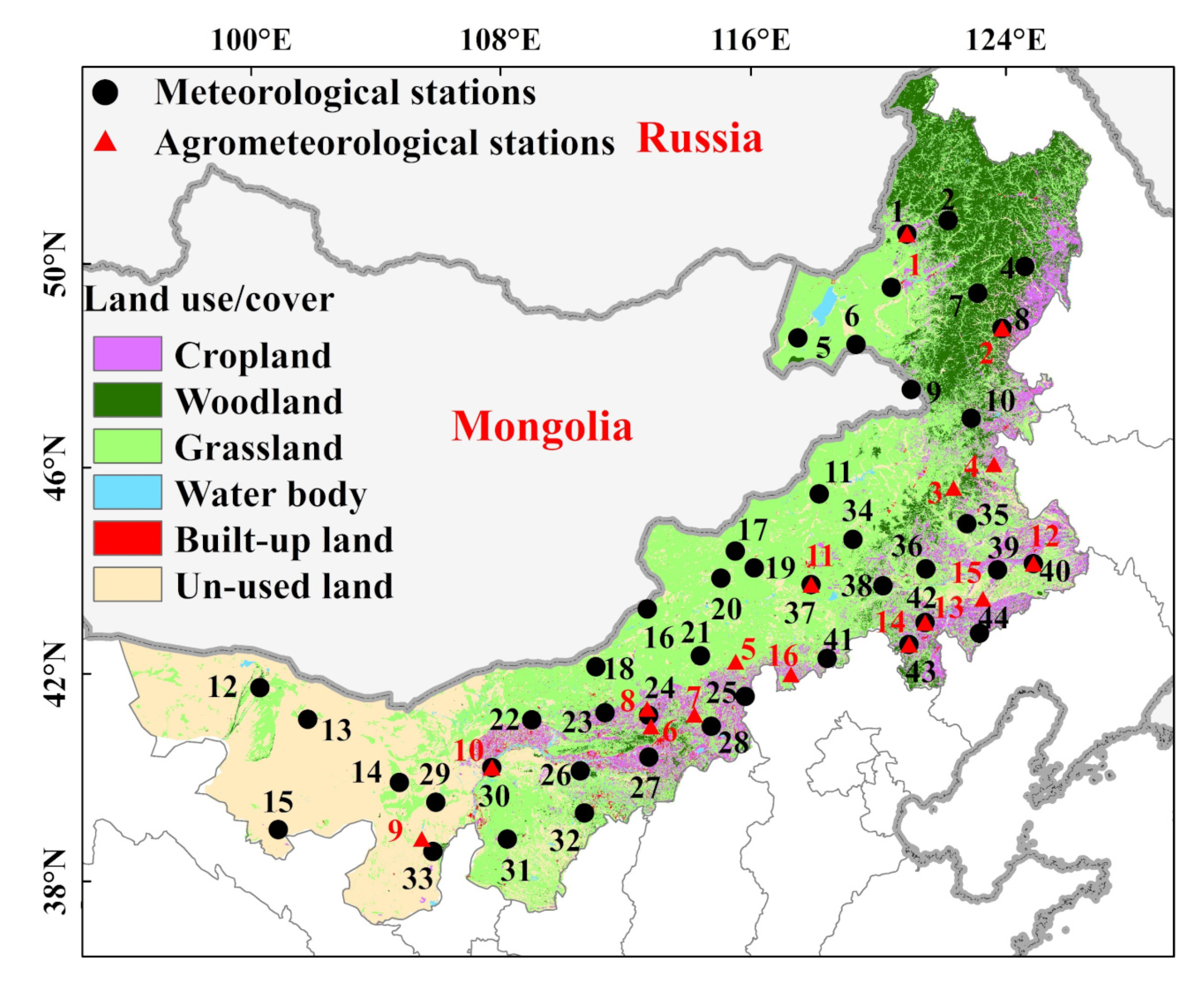

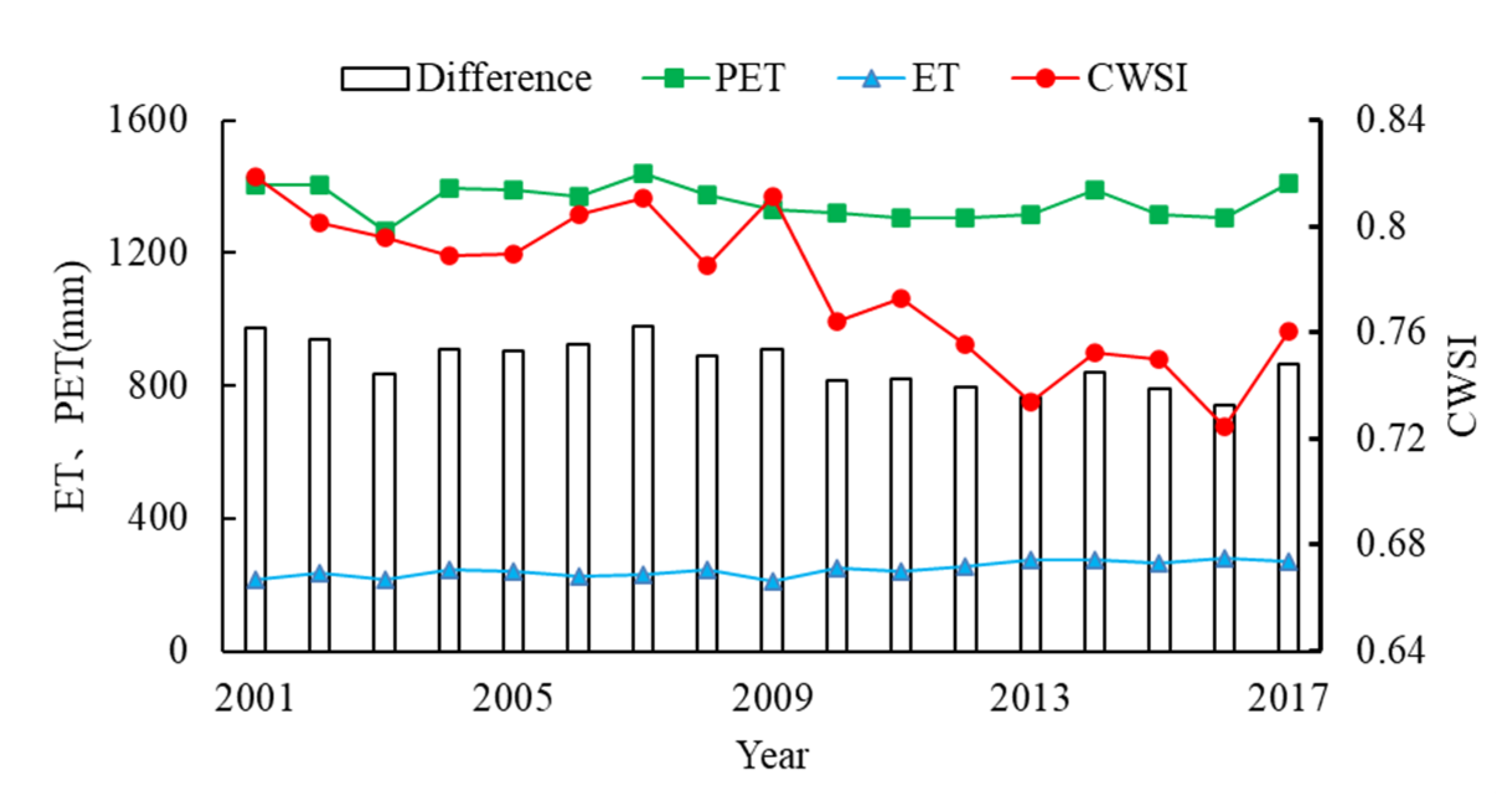
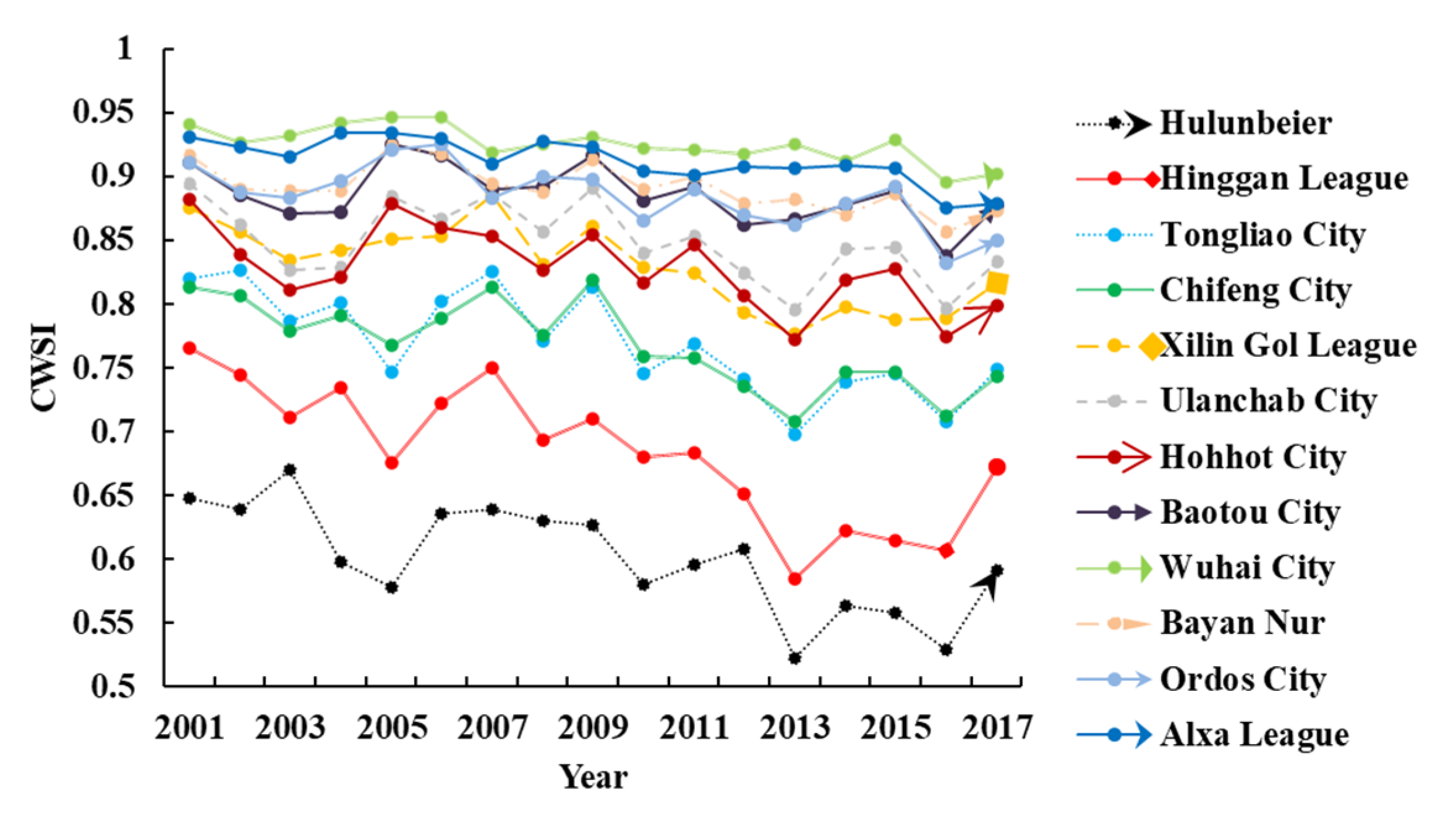
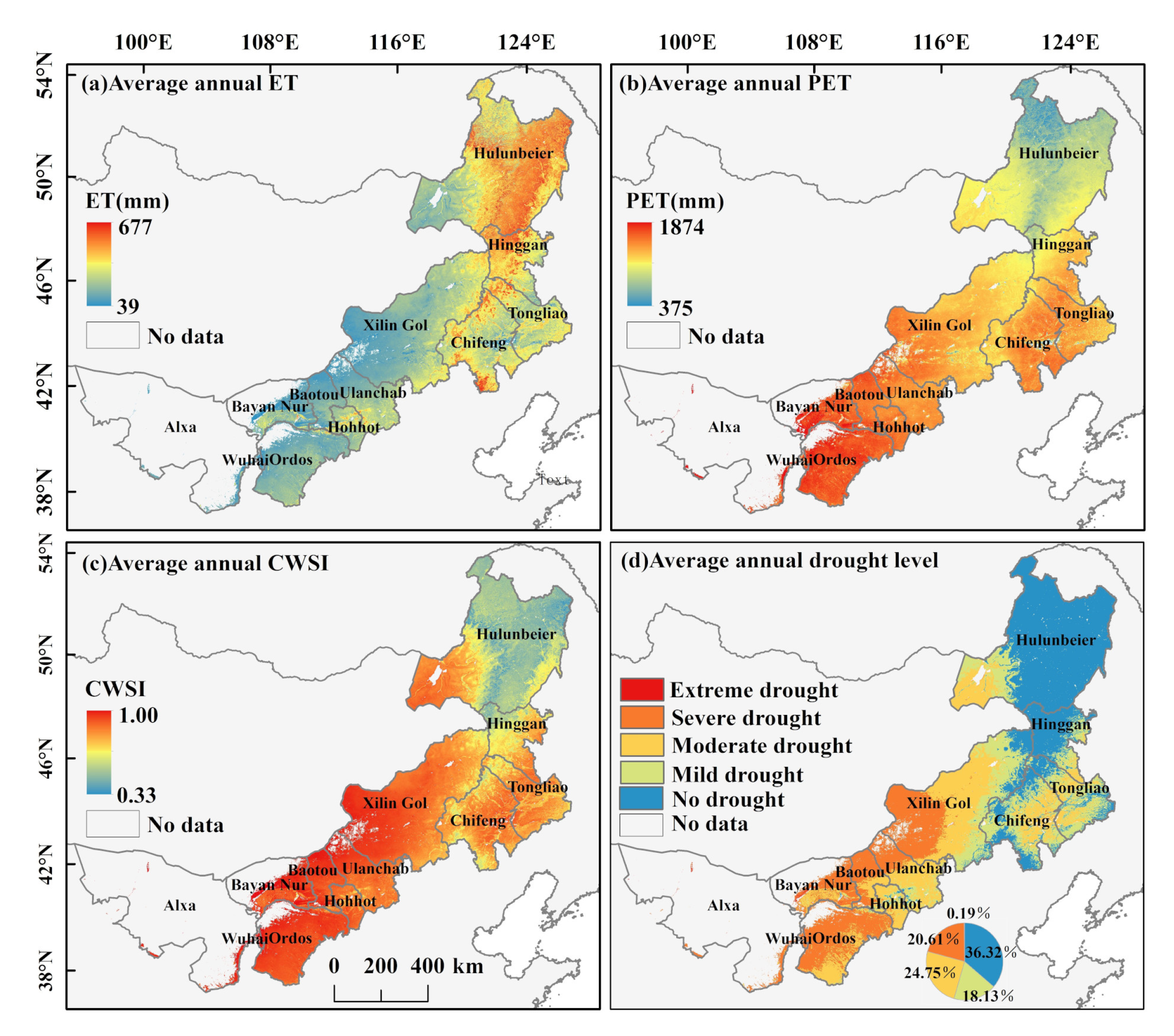

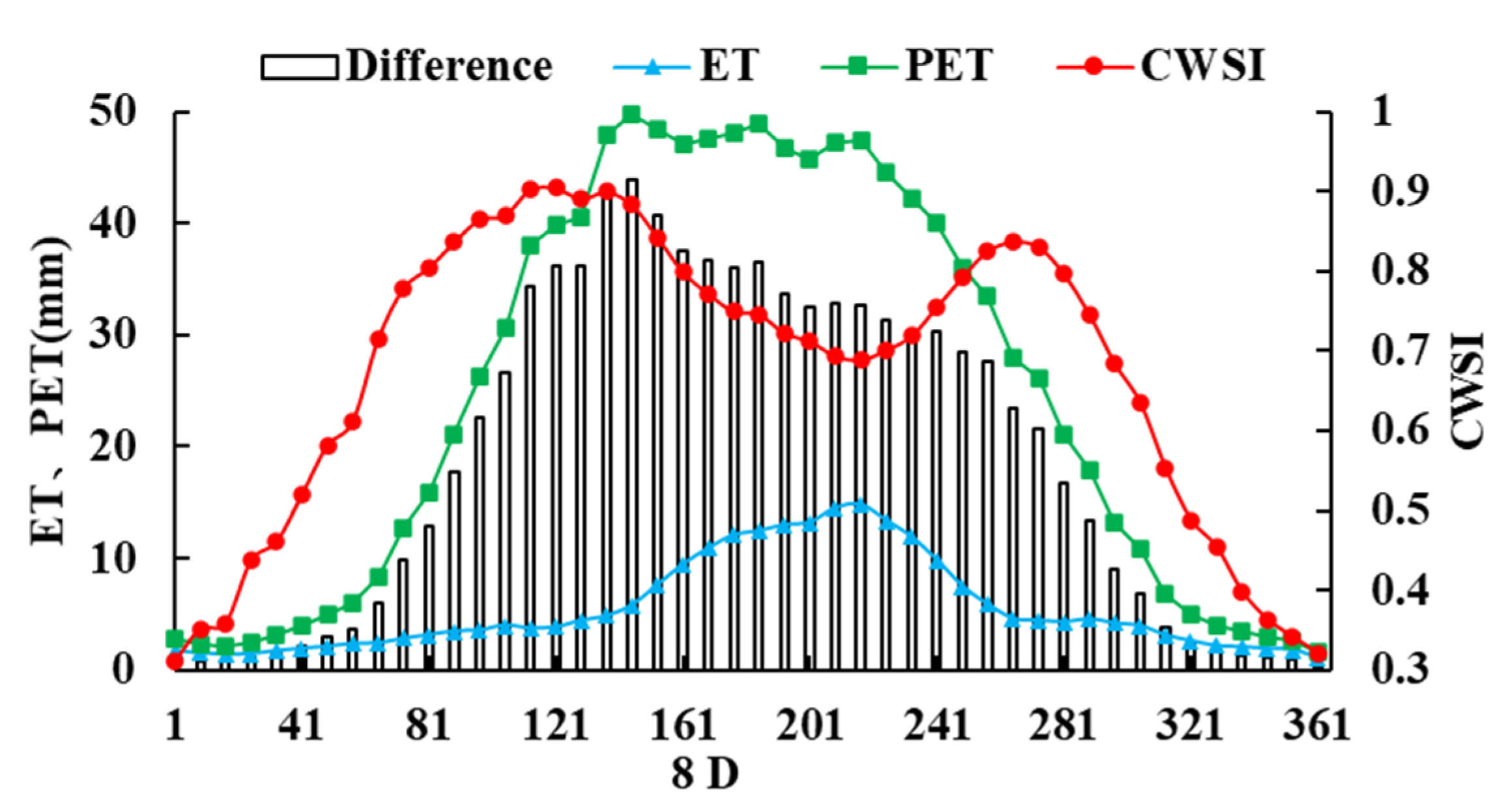
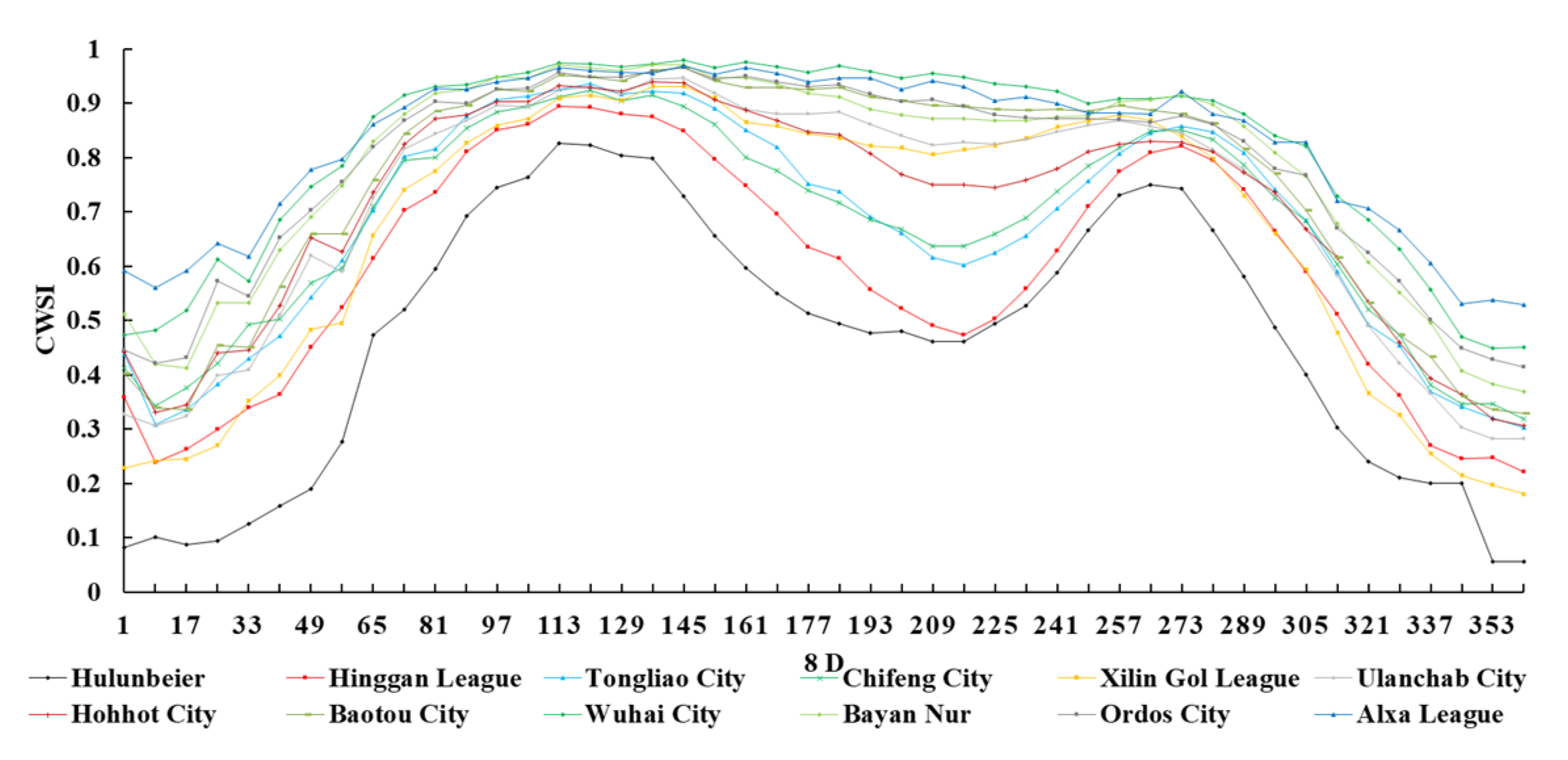
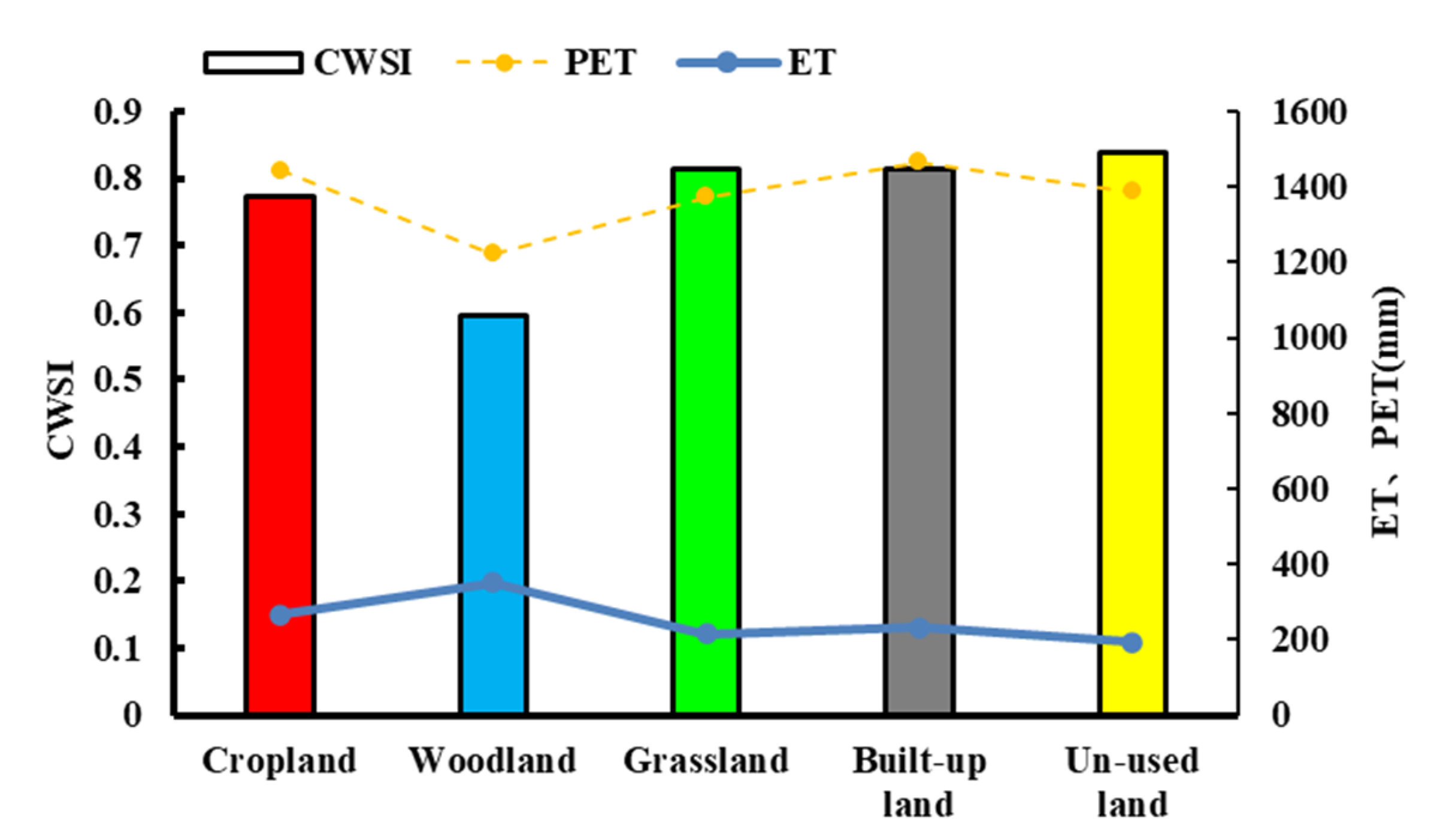
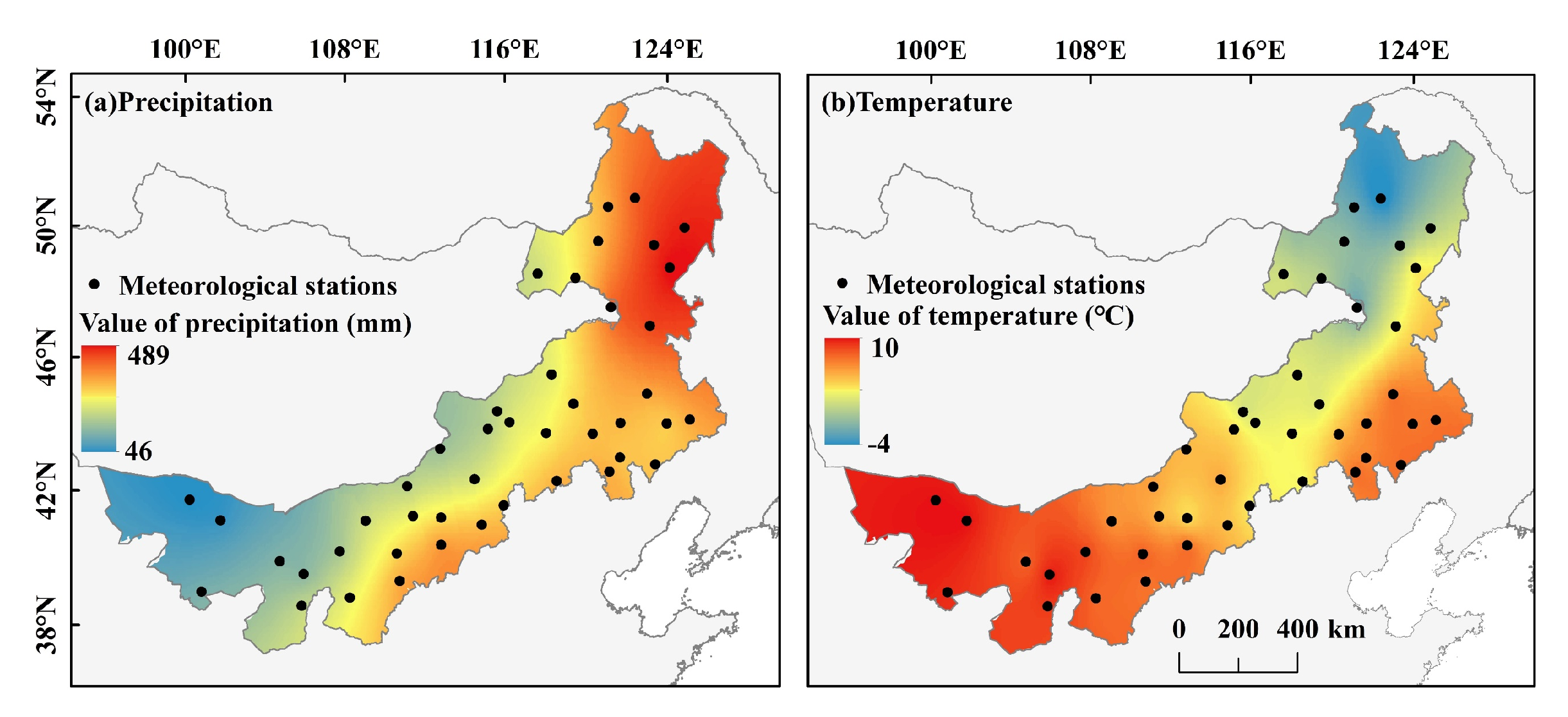
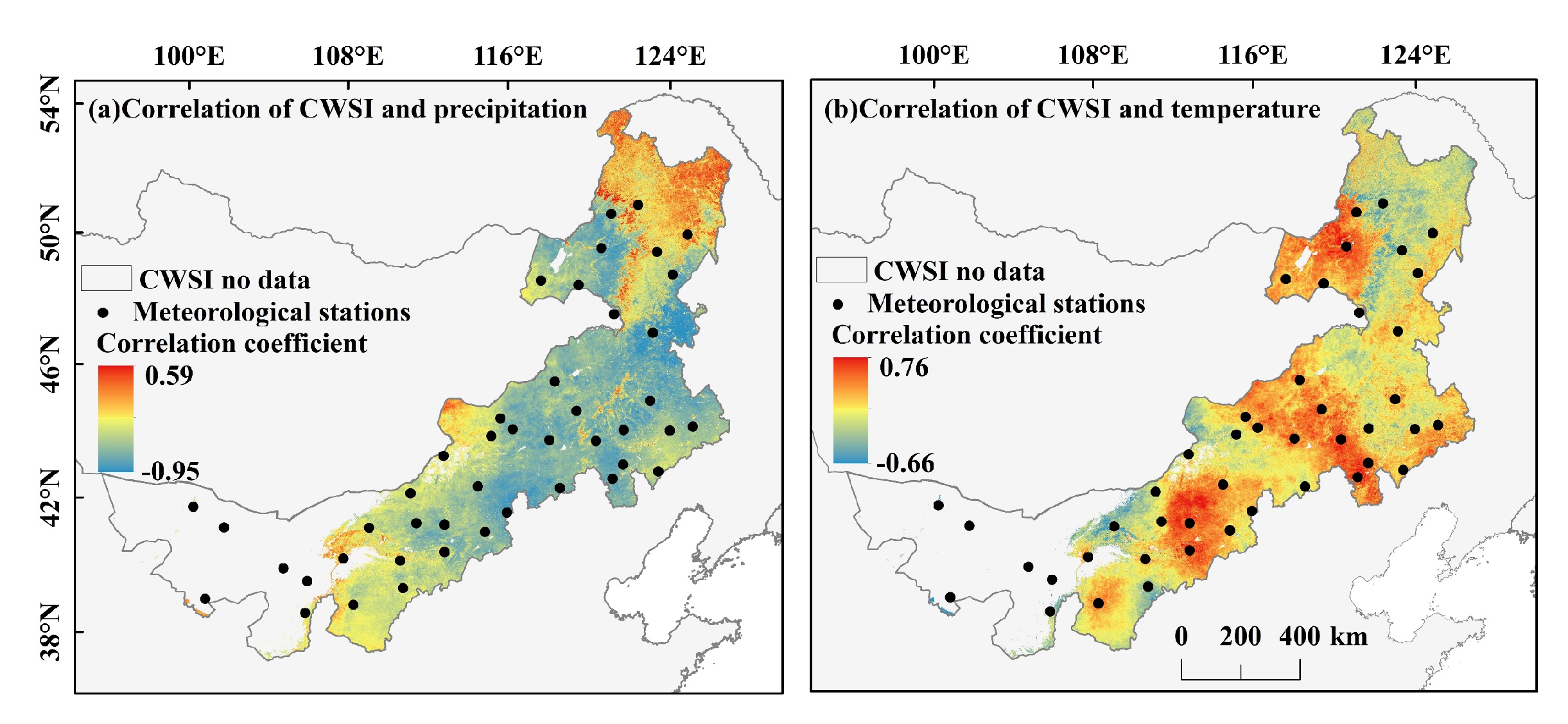
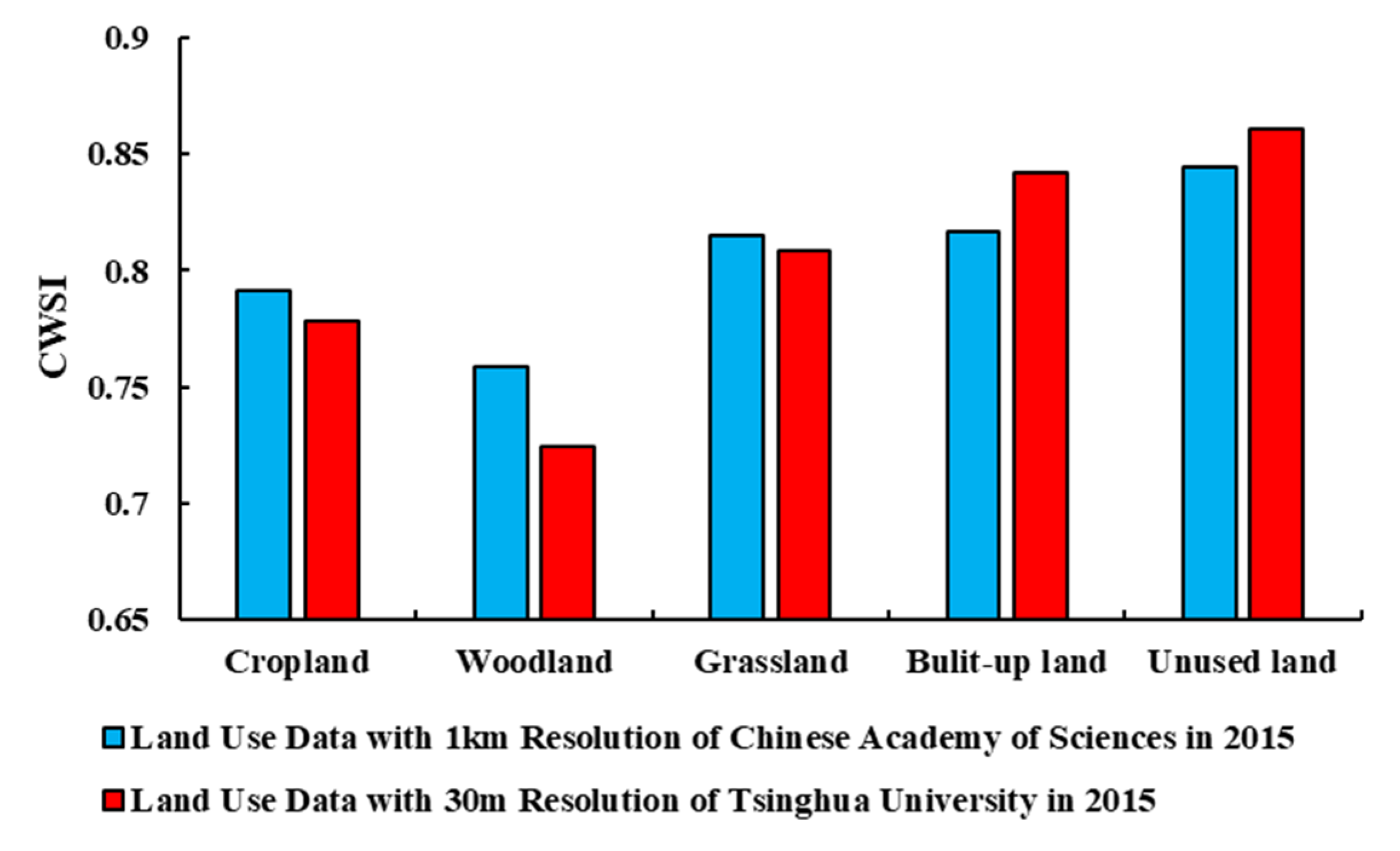
| Data | Data Content and Characteristics | Data Usage | Data Source |
|---|---|---|---|
| land use/cover | Content: Types of land use Spatial resolution: 1 km Time resolution: Year Time: 2000, 2005, 2010 and 2015 | Obtaining surface coverage information | (http://www.resdc.cn) |
| meteorological data | Content: Precipitation and temperature Time resolution: month Time: From 1957 to 2017 Number of stations: 44 | Getting grid data of precipitation and temperature | (http://data.cma.cn/data/) |
| Remote sensing data | Content: evapotranspiration and potential evapotranspiration Spatial resolution: 500 m Time resolution: 8 days Time: From 2001 to 2017 | Evapotranspiration and potential evapotranspiration were obtained and used to calculate crop water stress index (CWSI) | (https://ladsweb.modaps.eosdis.nasa.gov) |
| Relative soil moisture | Content: 20 cm relative soil moisture Time resolution: 10 days Time: From April to September in 2003–2009 and 2011 Number of stations: 17 | Used to verify the applicability of CWSI | (http://data.cma.cn/data/) |
| Number | Name of Stations | Longitude | Latitude | Average of Precipitation (mm) | Average of Temperature (°C) |
|---|---|---|---|---|---|
| 1 | Ergun City | 120.11 | 50.15 | 343 | −2 |
| 2 | Turi | 121.41 | 50.29 | 431 | −4 |
| 3 | Hailar | 119.42 | 49.15 | 330 | 0 |
| 4 | Xiaoergou | 123.43 | 49.12 | 493 | 1 |
| 5 | New Barag Right Banner | 116.49 | 48.4 | 197 | 2 |
| 6 | New Barag Left Banner | 118.16 | 48.13 | 271 | 1 |
| 7 | Bugt | 121.92 | 48.77 | 472 | 0 |
| 8 | Zhalantun | 122.44 | 48 | 495 | 4 |
| 9 | Arshan | 119.56 | 47.1 | 441 | −2 |
| 10 | Sauron | 121.13 | 46.36 | 462 | 3 |
| 11 | Dong Ujimqin | 116.58 | 45.31 | 231 | 3 |
| 12 | Ejin Banner | 101.07 | 41.95 | 33 | 10 |
| 13 | Gaizihu | 102.37 | 41.37 | 47 | 10 |
| 14 | Bayan Nuoer | 104.8 | 40.17 | 129 | 8 |
| 15 | Ayouqi | 101.68 | 39.22 | 123 | 10 |
| 16 | Erenhot | 111.56 | 43.38 | 124 | 5 |
| 17 | Na Renbaolige | 114.09 | 44.37 | 195 | 2 |
| 18 | Mandula | 110.08 | 42.32 | 174 | 6 |
| 19 | Abag Banner | 114.57 | 44.01 | 230 | 3 |
| 20 | Sonid left banner | 113.63 | 43.87 | 179 | 4 |
| 21 | Zhu Rihe | 112.9 | 42.4 | 200 | 6 |
| 22 | Wulate Middle Banner | 108.31 | 41.34 | 221 | 6 |
| 23 | Damao Banner | 110.26 | 41.42 | 259 | 5 |
| 24 | Siziwang Banner | 111.41 | 41.32 | 298 | 4 |
| 25 | Huade | 114 | 41.54 | 321 | 4 |
| 26 | Baotou City | 109.53 | 40.32 | 298 | 8 |
| 27 | Hohhot | 111.34 | 40.51 | 404 | 8 |
| 28 | Tsining | 113.04 | 41.02 | 354 | 5 |
| 29 | Girantai | 105.75 | 39.78 | 101 | 10 |
| 30 | Linhe | 107.22 | 40.44 | 137 | 9 |
| 31 | Otog Banner | 107.58 | 39.05 | 273 | 8 |
| 32 | Dongsheng County | 109.59 | 39.5 | 387 | 7 |
| 33 | Azuo banner | 105.67 | 38.83 | 220 | 9 |
| 34 | Xi Ujimqin | 117.36 | 44.35 | 293 | 2 |
| 35 | Jarud Banner | 120.54 | 44.34 | 346 | 8 |
| 36 | Baarin Left Banner | 119.24 | 43.59 | 341 | 7 |
| 37 | Xilin Hot | 116.07 | 43.57 | 261 | 3 |
| 38 | Linxi County | 118.02 | 43.38 | 332 | 5 |
| 39 | Kailu County | 121.17 | 43.36 | 309 | 7 |
| 40 | Tongliao | 122.16 | 43.36 | 347 | 8 |
| 41 | Duolun County | 116.28 | 42.11 | 360 | 3 |
| 42 | Ongniud Banner | 119.01 | 42.56 | 307 | 7 |
| 43 | Chifeng | 118.5 | 42.18 | 359 | 8 |
| 44 | Baoguotu | 120.42 | 42.2 | 372 | 8 |
| Number | Name of Stations | Longitude | Latitude | Relative Soil Moisture | CWSI |
|---|---|---|---|---|---|
| 1 | Ergun City | 120.11 | 50.15 | 0.52 | 0.76 |
| 2 | Zhalantun | 122.44 | 48 | 0.58 | 0.76 |
| 3 | Bayar tuhushuo | 120.33 | 45.07 | 0.53 | 0.80 |
| 4 | Tuquan | 121.55 | 45.4 | 0.60 | 0.78 |
| 5 | Bordered Yellow Banner | 113.83 | 42.23 | 0.43 | 0.90 |
| 6 | Wuchuan County | 111.45 | 41.1 | 0.45 | 0.87 |
| 7 | Chayou Middle Banner | 112.62 | 41.27 | 0.45 | 0.87 |
| 8 | Chayou Behind Banner | 111.38 | 41.45 | 0.39 | 0.89 |
| 9 | Xilingole | 105.38 | 39.08 | 0.30 | 0.95 |
| 10 | Linhe | 107.22 | 40.44 | 0.56 | 0.83 |
| 11 | Xilin Hot | 116.07 | 43.57 | 0.46 | 0.87 |
| 12 | Tongliao | 122.16 | 43.36 | 0.51 | 0.84 |
| 13 | Ongniud Banner | 119.01 | 42.56 | 0.64 | 0.75 |
| 14 | Chifeng | 118.5 | 42.18 | 0.67 | 0.73 |
| 15 | Neyman | 120.65 | 42.85 | 0.56 | 0.81 |
| 16 | Taipusi Banner | 115.27 | 41.88 | 0.57 | 0.81 |
| |P| | ||||
|---|---|---|---|---|
| |P| > 0.10 | 0.05 < |P| ≤ 0.10 | 0.01 < |P| ≤ 0.05 | |P| < 0.01 | |
| Slope ≤ 0 | Stable | Slight wet | wet | Significantly wet |
| Slope > 0 | Stable | Slight dry | dry | Significantly dry |
| Degree | RSM | CWSI | Degree of Drought |
|---|---|---|---|
| 1 | RSM > 0.60 | 0~0.77 | No drought |
| 2 | 0.50 < RSM ≤ 0.60 | 0.77~0.84 | Mild drought |
| 3 | 0.40 < RSM ≤ 0.50 | 0.84~0.90 | Moderate drought |
| 4 | 0.30 < RSM ≤ 0.40 | 0.90~0.96 | Severe drought |
| 5 | RSM ≤ 0.30 | 0.96~1 | Extreme drought |
Publisher’s Note: MDPI stays neutral with regard to jurisdictional claims in published maps and institutional affiliations. |
© 2021 by the authors. Licensee MDPI, Basel, Switzerland. This article is an open access article distributed under the terms and conditions of the Creative Commons Attribution (CC BY) license (http://creativecommons.org/licenses/by/4.0/).
Share and Cite
Ma, Z.-C.; Sun, P.; Zhang, Q.; Hu, Y.-Q.; Jiang, W. Characterization and Evaluation of MODIS-Derived Crop Water Stress Index (CWSI) for Monitoring Drought from 2001 to 2017 over Inner Mongolia. Sustainability 2021, 13, 916. https://doi.org/10.3390/su13020916
Ma Z-C, Sun P, Zhang Q, Hu Y-Q, Jiang W. Characterization and Evaluation of MODIS-Derived Crop Water Stress Index (CWSI) for Monitoring Drought from 2001 to 2017 over Inner Mongolia. Sustainability. 2021; 13(2):916. https://doi.org/10.3390/su13020916
Chicago/Turabian StyleMa, Zi-Ce, Peng Sun, Qiang Zhang, Yu-Qian Hu, and Wei Jiang. 2021. "Characterization and Evaluation of MODIS-Derived Crop Water Stress Index (CWSI) for Monitoring Drought from 2001 to 2017 over Inner Mongolia" Sustainability 13, no. 2: 916. https://doi.org/10.3390/su13020916
APA StyleMa, Z.-C., Sun, P., Zhang, Q., Hu, Y.-Q., & Jiang, W. (2021). Characterization and Evaluation of MODIS-Derived Crop Water Stress Index (CWSI) for Monitoring Drought from 2001 to 2017 over Inner Mongolia. Sustainability, 13(2), 916. https://doi.org/10.3390/su13020916







